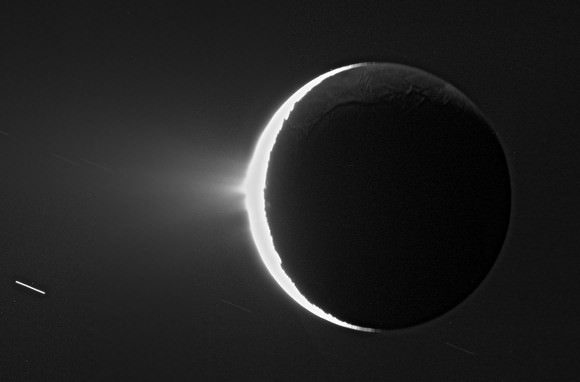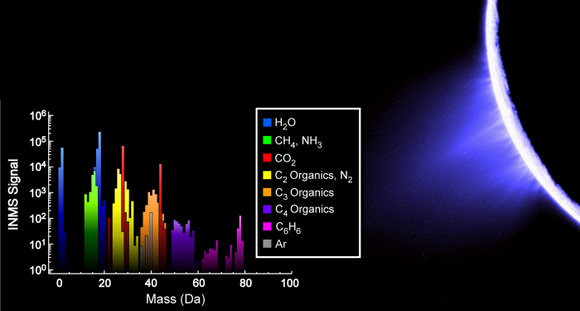[/caption]
A liquid plume is spewing from Saturn’s icy moon Enceladus — but is it coming from heated ice on the surface, or a liquid ocean underneath?
Analysis of the plume’s chemistry, detailed in the Cassini (CICLOPS) image above and reported in Nature this week, may put the debate to rest.

Lead author Jack Hunter (J.H.) Waite, of the Southwest Research Institute in San Antonio, Texas and his colleagues say ammonia detected in the jets from Enceladus’ south pole provides the strongest evidence yet for the existence of liquid water beneath the surface.
A previous paper led by Frank Postberg of the University of Heidelberg in Germany, published in Nature just last month, reported the discovery of salts in E-ring particles derived from the plume, also suggestive of a liquid reservoir.
But Susan Kieffer of the University of Illinois at Urbana–Champaign and her colleagues proposed in a 2006 Science paper that warm ice is heated near the surface, causing dissociation of clathrate hydrates. And Nicholas Schneider, of the University of Colorado at Boulder, and his colleagues published a paper in the same Nature issue as Postberg’s team (June 24) — reporting that there’s not enough sodium in the plume to support a liquid ocean.
The ammonia may tip the scales, say the authors of the new paper.
“The presence of ammonia provides strong evidence for the existence of at least some liquid water, given that temperatures in excess of 180K have been measured near the fractures from which the jets emanate,” the authors write. “We conclude, from the overall composition of the material, that the plume derives from both a liquid reservoir (or from ice that in recent geological time has been in contact with such a reservoir) as well as from degassing, volatile-charged ice.”
Besides ammonia, the authors detected various organic compounds and deuterium — ‘heavy’ hydrogen abundant in the oceans of Earth. Ammonia, together with methanol and salts, acts as an antifreeze, allowing liquid water to exist at below-freezing temperatures. The authors suggest that preserving even a residual oceanic layer during cooling episodes would maintain conditions necessary for tidal heating and geologic activity.
Enceladus is one of only three moons in the Solar System known to be volcanically active. The plume of gas and particles is thought to make up Saturn’s outermost ‘E’ ring.
UT ran a story last month, when Nature ran two papers with different ideas about whether Enceladus harbors a liquid ocean. See that story here.
Source for text: Nature. Source for images: Cassini Imaging Central Laboratory for Operations (CICLOPS), with thanks to study co-author William Lewis for the tip.


Now all we need is a fleet of probes to Enceladus, Titan, Europa and Triton!
Yes!
Let’s scrap the ISS and do that instead!
OK, sorry, won’t do it again! 😉
A fleet of probes would be much more exciting than ISS and possibly going back to the Moon…
I was pretty disheartened when they canceled JIMO back in 05. Apart from the cool fission-propulsion feel, it looked like it had potential to make some really revolutionary discoveries.
Hope the Laplace mission works out. I hear NASA’s testing out some cryobot out in Antarctica that would drill through to Europa’s ocean.
Does anyone know Charlie Bolden’s views on science missions like this? What are his tendencies and priorities?
@Andy:
I couldnt agree more with you!
The return to the moon is thrilling for sure, but people should look for some answers about life in our solar system (NOT ONLY MARS!).
ISS uses more money than a floater/baloon mission to Titan, a LOT MORE!!
Yay!
[Salivating] So a surviving sea would be a good competitor to the only-liquid-when-in resonance idea? [/Salivating]
The ISS may not be exciting, but it’s the most significant experiment if we ever intend to be space travelers.